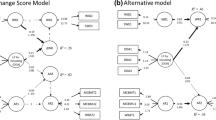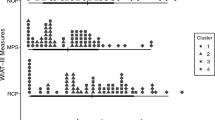Abstract
Reading achievement, IQ, and behavior problems were assessed in second and eighth grade for a longitudinal sample of 57 children. Changes in these scores over time were compared for children with no learning disabilities versus children with math or reading disabilities (research-identified and/or school-identified). A widening of the group difference in IQ was seen between the math disabled and nondisabled groups, but otherwise the gaps between groups remained unchanged or narrowed over the six-year interval, indicating that hypothesized negative consequences of initial academic difficulties (“Matthew effects”) did not occur for most of the children with learning disabilities. Elevated rates of behavior problems were seen only for the group with math disabilities, suggesting that the type of learning disability needs to be taken into account in research on the association between academic and psychosocial problems.
Similar content being viewed by others
References
Achenbach, T. M., & Edelbrock, C. (1981). Behavioral problems and competencies reported by parents of normal and disturbed children aged four to sixteen. Monographs of the Society for Research in Child Development, 46(1, Serial No. 188).
Achenbach, T. M., & Edelbrock, C. (1983). Manual for the child behavior checklist and revised child behavior profile. Burlington, VT: University of Vermont.
Allington, R. L. (1983). The reading instruction provided readers of differing reading abilities. The Elementary School Journal, 83, 548–559.
Anderson, R. C., & Freebody, P. (1979). Vocabulary knowledge (Technical Report No. 136). Urbana-Champaign, IL: Center for the Study of Reading, University of Illinois.
Bachman, J., & O’Malley, P. (1977). Self-esteem in young men: A longitudinal analysis of the impact of educational and occupational attainment. Journal of Personality and Social Psychology, 35, 365–380.
Badian, N. A. (1983). Dyscalculia and nonverbal disorders of learning. In H. R. Myklebust (Ed.). Progress in learning disabilities (vol. V) (pp. 235–264). New York: Grune & Stratton.
Badian, N. A., & Ghublikian, M. (1983). The personal-social characteristics of children with poor mathematical computation skills. Journal of Learning Disabilities, 16, 154–157.
Baker, L. A., Decker, S. N., & DeFries, J. C. (1984). Cognitive abilities in reading-disabled children: A longitudinal study. Journal of Child Psychology and Psychiatry, 23, 111–117.
Bast, J., & Reitsma, P. (1998). Analyzing the development of individual differences in terms of Matthew effects in reading: Results from a Dutch longitudinal study. Developmental Psychology, 34, 1373–1399.
Bauman, E. (1991). Stability of WISC-R scores in children with learning difficulties. Psychology in the Schools, 28, 95–100.
Biemiller, A. (1977–1978). Relationships between oral reading rates for letters, words, and simple tests in the development of reading achievement. Reading Research Quarterly, 13, 223–253.
Brainerd, C. J., Kingma, J., & Howe, M. L. (1986). Long-term memory development and learning disability: Storage and retrieval loci of disabled/nondisabled differences. In S. J. Ceci (Ed.). Handbook of cognitive, social, and neuropsychological aspects of learning disabilities (vol. 1) (pp. 161–184). Hillsdale, NJ: Lawrence Erlbaum Associates.
Bryan, T. (1974). Peer popularity of learning disabled children. Journal of Learning Disabilities, 7, 261–268.
Burstall, C. (1979). The Matthew effect in the classroom. Educational Research, 21, 19–25.
Butkowski, S., & Willows, D. (1980). Cognitive-motivational characteristics of children varying in reading ability: Evidence for learned helplessness in poor readers. Journal of Educational Psychology, 72, 408–422.
Catts, H., Fey, M., Zhang, X., & Tomblin, J. B. (1999). Language basis of reading and reading disabilities: Evidence from a longitudinal study. Scientific Studies of Reading, 3, 331–361.
Catts, H. W., Hogan, T. P., & Fey, M. E. (2003). Subgrouping poor readers on the basis of individual differences in reading-related abilities. Journal of Learning Disabilities, 36, 151–164.
Chall, J. S. (1983). Stages of reading development. New York: McGraw-Hill.
Chapman, R. B., Larsen, S. C., & Parker, R. M. (1979). Interactions of first grade classroom teachers with learning disordered students. Journal of Learning Disabilities, 12, 225–230.
Cornwall, A., & Bawden, H. N. (1992). Reading disabilities and aggression: A critical review. Journal of Learning Disabilities, 25, 281–288.
Dickman, G. E. (1996). The link between learning disabilities and behavior. In S. C. Cramer & W. Ellis (Eds.). Learning disabilities: Lifelong issues (pp. 215–228). Baltimore: Paul H. Brookes Publishing Company.
Fuerst, D. R., & Rourke, B. P. (1995). Patterns of psychosocial functioning of children with learning disabilities at three age levels. Child Neuropsychology, 1, 38–55.
Garrett, M. K., & Crump, W. D. (1980). Peer acceptance, teacher preference and self-appraisal of social status of learning disabled students. Learning Disability Quarterly, 3, 42–47.
Hinshaw, S. P. (1992). Externalizing behavior problems and academic underachievement in childhood and adolescence: Causal relationships and underlying mechanisms. Psychological Bulletin, 111, 127–155.
Hollingshead, A. B., & Redlich, F. C. (1958). Social class and mental illness. New York: Wiley.
Huntington, D. D., & Bender, W. N. (1993). Adolescents with learning disabilities at risk? Emotional well-being, depression, suicide. Journal of Learning Disabilities, 26, 159–166.
Hynd, G. W., Miller, C. J., Sanchez, J., Lindstrom, W. A., & Jones, L. (2002, November). Findings from the University of Georgia’s NIH-funded research clinic. Paper presented to the annual meeting of the International Dyslexia Association, Atlanta.
Jordan, N. C., Kaplan, D., & Hanich, L. B. (2002). Achievement growth in children with learning difficulties in mathematics: Findings of a two-year longitudinal study. Journal of Educational Psychology, 94, 586–597.
Jorm, A. F., Share, D. L., Maclean, R., & Matthews, R. (1986). Cognitive factors at school entry predictive of specific reading retardation and general reading backwardness: A research note. Journal of Child Psychology and Psychiatry, 27, 45–54.
Juel, C. (1988). Learning to read and write: A longitudinal study of 54 children from first through fourth grades. Journal of Educational Psychology, 80, 437–447.
Kavale, K. A., & Forness, S. R. (1996). Social skill deficits and learning disabilities: A meta-analysis. Journal of Learning Disabilities, 29, 226–237.
Kinsbourne, M., & Caplan, P. J. (1979). Children’s learning and attention problems. Boston: Little, Brown.
McGee, R., Williams, S., Share, D. L., Anderson, J., & Silva, P. A. (1986). The relationship between specific reading retardation, general reading backwardness and behavioral problems in a large sample of Dunedin boys: A longitudinal study from five to eleven years. Journal of Child Psychology and Psychiatry, 27, 597–610.
McKinney, J. D., & Feagans, L. (1984). Academic and behavioral characteristics: Longitudinal studies of learning disabled children and average achievers. Learning Disability Quarterly, 7, 251–265.
Miller, C. J. (2002). Parental contributions to child reading achievement, phonological processing, rapid naming ability, and internalizing behaviors. Unpublished doctoral dissertation, University of Georgia.
Oakman, S., & Wilson, B. (1988). Stability of WISC-R intelligence scores: Implications for 3-year evaluations of learning disabled students. Psychology in the Schools, 25, 118–120.
Phillips, L. M., Norris, S. P., Osmond, W. C., & Maynard, A. M. (2002). Relative reading achievement: A longitudinal study of 187 children from first through sixth grades. Journal of Educational Psychology, 94, 3–13.
Pintrich, P. R., Anderman, E. M., & Klobucar, C. (1994). Intraindividual differences in motivation and cognition in students with and without learning disabilities. Journal of Learning Disabilities, 27, 360–370.
Roth, F., & Spekman, N. J. (1986). Narrative discourse: Spontaneously generated stories of learning-disabled and normally achieving students. Journal of Speech and Hearing Disorders, 51, 8–23.
Rourke, B. P., & Fuerst, D. (1995). Cognitive processing, academic achievement and socioemotional functioning: A neuropsychological perspective. In D. Cicchetti & D. Cohen (Eds.). Manual of developmental psychopathology (vol. 1) (pp. 391–423). New York: Wiley.
Sattler, J. (1992). Assessment of children (3rd ed.). San Diego, CA: author.
Scarborough, H. S. (1989). Prediction of reading disability from familial and individual differences. Journal of Educational Psychology, 81, 101–108.
Scarborough, H. S. (1990). Very early language deficits in dyslexic children. Child Development, 61, 1728–1734.
Scarborough, H. S. (1998). Predicting the future achievement of second graders with reading disabilities: Contributions of phonemic awareness, verbal memory, rapid naming, and IQ. Annals of Dyslexia, 48, 115–136.
Scarborough, H. S., & Layfer, J. (1996, April). A follow-up study of children with learning disabilities: Academic, cognitive, and psychosocial outcomes in adolescence. Paper presented at the meeting of the Society for the Scientific Study of Reading, New York.
Share, D. L., & Silva, P. A. (1987). Language deficits and specific reading retardation: Cause or effect? British Journal of Disorders of Communication, 22, 219–226.
Shaywitz, B. A., Holford, T. R., Holahan, J. M., Fletcher, J. M., Stuebing, K. K., Francis, D. J., & Shaywitz, S. E. (1995). A Matthew effect for IQ but not for reading: Results from a longitudinal study. Reading Research Quarterly, 30, 894–906.
Siegel, L., & Ryan, E. (1984). Reading disability as a language disorder. Remedial and Special Education, 5, 28–33.
Stanovich, K. E. (1986). Matthew effects in reading: Some consequences of individual differences in the acquisition of literacy. Reading Research Quarterly, 21, 360–407.
Stanovich, K. E. (1988). The right and wrong places to look for the cognitive locus of reading disability. Annals of Dyslexia, 38, 154–177.
Stone, W. L., & La Greca, A. M. (1994). Social deficits in children with learning disabilities. In A. J. Capute, P. J. Accardo, & B. K. Shapiro (Eds.). Learning disabilities spectrum: ADD, ADHD, and LD (pp. 155–175). Baltimore: York Press.
Tsatsanis, K. D., Fuerst, D. R., & Rourke, B. P. (1997). Psychosocial dimensions of learning disabilities: External validation and relationship with age and academic functioning. Journal of Learning Disabilities, 30, 490–502.
Torgesen, J., & Dice, C. (1980). Characteristics of research in learning disabilities. Journal of Learning Disabilities, 13, 531–535.
Vance, H. B., Blixt, S., Ellis, R., & Debell, S. (1981). Stability of the WISC-R for a sample of exceptional children. Journal of Clinical Psychology, 37, 397–399.
Vance, H. B., Hankins. N., & Brown, W. (1987). A longitudinal study of the Wechsler Intelligence Scale for Children - Revised over a six-year period. Psychology in the Schools, 24, 229–33.
Vaughn, S., Zaragoza, N., Hogan, A., & Walker, J. (1993). A four-year longitudinal investigation of the social skills and behavior problems of students with learning disabilities. Journal of Learning Disabilities, 26, 404–412.
Walberg, H. J., & Tsai, S. L. (1983). Matthew effects in education. American Educational Research Journal, 20, 359–373.
Wechsler, D. (1989). Wechsler intelligence scale for children - Revised. San Antonio, TX: The Psychological Corporation.
Williamson, G. L., Appelbaum. M., & Epanchin, A. (1991). Longitudinal analyses of academic achievement. Journal of Educational Measurement, 28, 61–76.
Wolf, M., & Goodglass, H. (1986). Dyslexia, dysnomia, and lexical retrieval: A longitudinal investigation. Brain and Language, 28, 154–168.
Woodcock, R., & Johnson, M. B. (1978). Woodcock-Johnson Psychoeducational Battery. Allen Park, TX: DLM Teaching Resources.
Author information
Authors and Affiliations
Corresponding author
Rights and permissions
About this article
Cite this article
Scarborough, H.S., Parker, J.D. Matthew effects in children with learning disabilities: Development of reading, IQ, and psychosocial problems from grade 2 to grade 8. Ann. of Dyslexia 53, 47–71 (2003). https://doi.org/10.1007/s11881-003-0004-6
Received:
Accepted:
Issue Date:
DOI: https://doi.org/10.1007/s11881-003-0004-6




